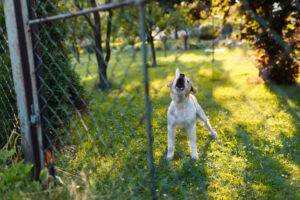
Problem Barking: A Positive Approach
Barking; to a dog it’s natural to vocalize when they’re excited, startled, or bored. However, when your dog engages in repetitive barking it quickly becomes a loud and nerve-wracking issue. Your instinct may be to yell or punish your dog but resist that urge. Doing so will only deteriorate trust and make training more difficult. Luckily dogs are forgiving creatures and moving forward with positivity will mend the bond with your dog. A few simple training exercises will easily eliminate problem barking.
WHY ARE THEY BARKING?
Some dogs bark when they want attention or food. Sometimes dogs bark to alert you that something is happening, such as the mail carrier’s arrival or a squirrel digging in your front yard. Some dogs bark when you bring out their leash to go for a walk. Identify which type of barking your dog is engaging in so you can start to train the desired behavior.
REWARD GOOD BEHAVIOR, IGNORE UNDESIRED BEHAVIOR
 Humans are hard-wired to respond to calls of distress and a whining or barking dog can sound distressing. Canines, on the other paw (sorry not sorry), ignore undesired behavior. Taking a cue from how canines communicate, ignore the barking. After 5 or so seconds of quiet, reward them! A favorite toy, a treat, praise, or all of the above will get your message across.
Humans are hard-wired to respond to calls of distress and a whining or barking dog can sound distressing. Canines, on the other paw (sorry not sorry), ignore undesired behavior. Taking a cue from how canines communicate, ignore the barking. After 5 or so seconds of quiet, reward them! A favorite toy, a treat, praise, or all of the above will get your message across.
Alert barking is a different issue altogether, but the reward pattern is the same. Alert barking can be self-rewarding as the target moves away and your dog has successfully “vanquished” them. Catch your dog before they begin to bark and ask them for a desired action such as: sit, stay, or go to their bed. Find out your dog’s tolerance level so you can interrupt barking before it happens. For example, if you see a person walking their dog and your dog doesn’t start barking until they’re 10 feet away, you now know to ask your dog for the desired action at 15 feet. Treats and praise should follow! Throw in a little play session as well to really make your point. If you don’t have time to train your dog, simply eliminate the source of their barking to temporarily fix the issue. Draw the curtains or install a visual barrier by the fence.
When working with excitement barking, pay attention to the cues that cause the barking and work on desensitizing your dog. Bringing out the leash or a toy is a common cause of overexcitement and vocalization; using the same method as alert barking, find out your dog’s tolerance level. Try briefly touching the object and ask for desired behavior. Slowly move up to holding the object. Reward them for a quiet job well done!
Anxious barking that occurs when a dog is left alone can easily be fixed through enrichment games and puzzle toys. Hide toys or treats around your house and encourage her to seek them out, or feed your dog using Kongs. Giving your dog a puzzle toy filled with food is a wonderful way to leave them for the day! Severe cases involving destruction or the inability to calm down may require assistance from a trainer.
BARKING BECOMES CUTE
Barking on command is a fun training exercise in which you use your dog’s normal behavior to your advantage. Encourage barking with a vocal and visual cue, followed by treats and praise. When the barking ends, give a vocal and visual command and reward your dog. Over time they will learn to stop (and start) barking when given the command.
Falling back on rewarding undesired behavior is a big temptation, but resist the urge to give up. Training is hard work and requires diligence and consistency. Your bond with your dog strengthens every time you utilize reward-based training and they’ll come to look forward to your training sessions.
What challenges have you faced when living with problematic barking? Share your successes and ask questions below.
My little guy PJ barks when anyone comes to the door even when he can’t see them but can hear them such as keys being inserted in the lock etc. My adult daughter loves him and she lives with me but she gets irritated when he barks at her when she comes home. I don’t know her schedule and it varies day to day and it is unrealistic and impractical to expect her to message me when she is about to come home so I can distract him. I am often on my phone working anyway. What are your suggestions for unanticipated things like this that cause barking?
Hi Laura! I’d start by repeating the sound of the keys in the lock while treating PJ (when he’s not barking) and you’re inside with him. If he’s barking even when he can see you and you’re making the sound, try just jangling keys to gauge his reaction. Break down every step to desensitize him towards the sounds and the movement of a person entering the house. For example, jangling keys, moving through an exterior door, keys in the lock, etc. Repeat these noises and movements with treats as a reward for his silence. Timing is important as we don’t want to treat a dog when they’re barking as that will reinforce the behavior. Good luck with PJ’s barking progress!